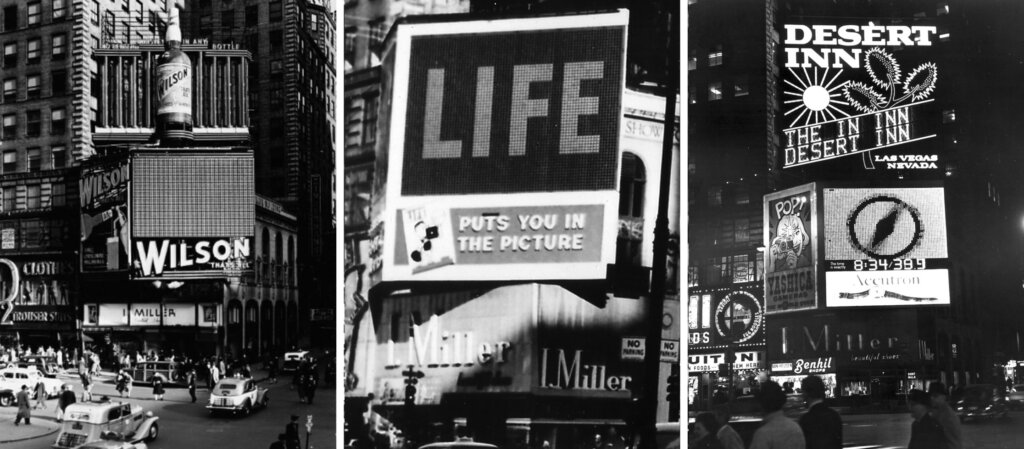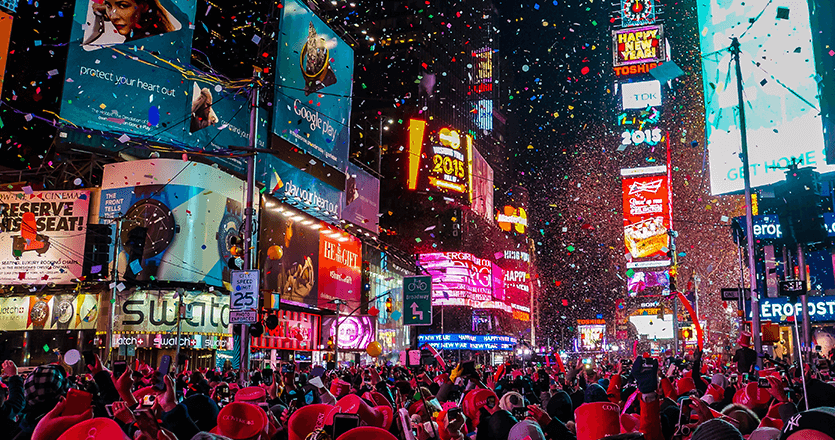Welcome to a special investigation examining the journey of digital signage in New Year’s Eve Celebrations via a well deserved trip to Times Square!
As the clock ticks towards midnight on December 31st each year, millions of eyes around the world turn to screens–massive billboards in public squares, television sets in cozy living rooms, and smartphones in hands. This moment reflects a fascinating intersection of technology, culture, and communal experience.
And although this fascination with screens is a recent development in the long history of NYE celebrations, it has changed the way we usher in the New Year forever.
How did digital displays evolve to play such an essential role in one of humanity’s oldest celebrations? We will take a look at the journey of digital signage technology from its nascent stages to becoming a central component of the global New Year countdown.
Quick History
The concept of watching a countdown on a screen is largely a product of the 20th century. It evolved alongside advancements in technology and changes in social and cultural habits.
The very tradition of celebrating the New Year though dates back thousands of years. Almost all major ancient civilizations marked the beginning of the new year with festivities and rituals.
Our story really begins during the 19th century. That’s when urbanization increased and public New Year’s Eve celebrations became more common. More and more people would gather in squares and major streets to countdown to midnight. And thus a new customary experience of bidding farewell to the passing year started to slowly cement itself.
Then in the last moments of 1907, a pivotal event took place in New York. The first Times Square Ball Drop was staged, an event that would become iconic for NYE celebrations around the world.
The event also became one of the earliest televised New Year’s events, first broadcasted in the 1950s. It is still going strong today, and has become the focal point of New York’s festive spirit during NYE.

Times Square and its Digital Signage History
The exact history of digital signage use is not well documented. Meanwhile, the term has come to mean different things throughout the years.
Numerous small advancements led to Times Square’s New Year’s Eve celebration, with its array of dazzling displays, becoming a visual template emulated in cities worldwide.
When was the fist digital sign installed?
Nonetheless the story of signage, first electronic and then digital, began much earlier, in 1946. It was at that year that the first digital display was installed in Times Square. The display featured a bank of 4104 incandescent light bulbs which could display images in high contrast black and white. It was only properly displaying content at night as the lamp bank was activated by photoelectric cells onto which a film loop was projected in real time.

This may seem rudimentary by today’s standards, but the display was in use until the early 1970s. This was a monumental chapter in the history of digital signage and OOH advertising in general.
Along with this development, many other forms of innovative signage, such as early light news tickers near street level, were instrumental in turning Times Square into a testing ground for signage innovation, public information dissemination, and communal celebration.
Broadcasting, Large-Scale Displays, and the 21st century
The relationship between screens and New Year’s celebrations further developed with the advent of television. And later with the proliferation and increased accessibility of public digital displays.
Families gathered around their radios and, later, TV sets to listen to or watch celebrations from faraway locations. The earliest televised Times Square Ball Drop in New York City, brought the energy of Times Square into homes across the country and became a national tradition.
The current era of digital display evolution begins with the introduction of large-scale digital screens in public spaces. In 1996, Times Square saw the installation of its first Jumbotron, a giant LED screen that brought a new level of spectacle to the area.
These video board screens were not just larger and brighter than anything before them; they were also capable of displaying dynamic content, from live feeds to animated graphics, changing out-of-home advertising and event broadcasting forever.
After that, it took only a few years before Times Square was taken over by digital signage. The Y2K celebration and its countdown, were among the first global events extensively covered by both television and the nascent internet, setting the stage for a new era in New Year’s Eve celebrations broadcasting.
The now ubiquitous digital screens turned the square into an example of how high traffic public spaces around the world would follow its path with animated screens for advertising, public information dissemination, and communal celebration.

Screens and the New Year
The evolution of Times Squares shows just how far has signage technology really come. From its first nascent states to breathtaking displays today. It also shows how it affects our most basic sensations in that it illuminates, moves, and brings people closer to celebrate together.
The history of digital signage and Times Square serves as a fine example of how technology can amplify and elevate the human experience in public spaces. We at Yodeck pride ourselves on that we have democratized digital signage technology by offering a powerful, yet accessible, cloud-based solution that can animate your digital screens and transform your impact around you.
You can start for free or book a demo if you want to know more about our product!
Happy New Year!
